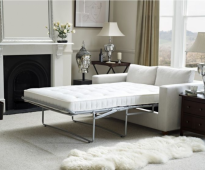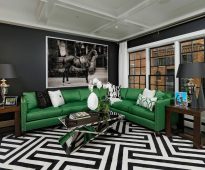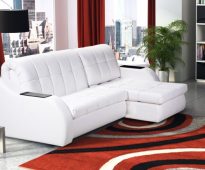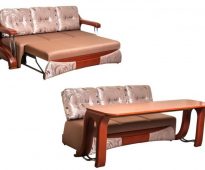 Sofa with the "French folding bed" mechanism: pros and cons
Sofa with the "French folding bed" mechanism: pros and cons
Creating Crochet Tacks: A Beginner's Guide
To bring a touch of originality into the design of the kitchen is sometimes quite an insignificant detail. For example, such an accent as a bright and expressive tack in the kitchen will surely attract the eye and delight in manual work.
Content
Materials and tools for knitting tacks
Since the purpose of the tack - is not only aesthetic beauty, but also protection of hands from burns, then the choice of materials for its manufacture should be approached in a special way.
Important! In no case do not choose yarn from viscose and silk. They will not prevent burns.
Cotton, acrylic and wool are best suited for this purpose. But they can not be combined so as not to lose the shape of the product during operation.
Choosing a thick yarn, you should avoid any thickening in its structure, since the implementation of patterns with such a thread will make it impossible to use it in work with hot surfaces.
Crochet tack: schemes and description
Flower
Choosing the elements of floristics and experimenting with color solutions in their design, you can always create a unique thing, harmoniously combined with the interior of the kitchen. Choose no more than two contrasting colors.
Additional Information! In order to preserve the shape and color of the product, it is enough just to periodically wash it in cool water. After it should starch and iron it.
- The center should start with a dark color, having closed 8 air loops in a ring.
- The second row consists of 18 Art. s.n.
- In the third by 1 second column, they knit and connect another loop of 23 air ones. Having connected further 1 st.b. get 9 extra loops with 1 same column in between.
- Two subsequent rows are tied with the resulting loops. The top of each loop is added in three columns without a single crochet.
- The sixth and seventh color change, but retain the previous order of work.
- In the 10th I am counting down 7 st. B.N., to wrap them in a petal and connect with the eighth.
You can knit tack as knitting, and crochet. It all depends on the type of ornament and the thickness of the yarn.
Helix
The essence of making such tacks is that several colors are used at once in a single circular row. The complexity of this weaving is only in the fact that while one color is involved, the other loops remain open.
Important! So that the free loops are not tangled and not dissolved, it is worth fixing them with a marker capable of blocking them. Pins or clips can serve as such "markers".
For the manufacture of tacks need 5 colors of cotton yarn of 100 g, 4 markers and hook number 4. The diameter of the finished product will be 21 cm.
In advance we will accept designations for flowers:
A - red;
B - brick;
B - orange;
G - yellow;
D - beige.
To begin with, we make an inner ring of the darkest color - 1 air loop, 1 tbsp.b.n., 1 p. sn, 2 tbsp. s.n. Having attached a new thread, we repeat the process again with each subsequent color.
In the first row we carry out 2 colors for each color. s.n. from one loop and 1 tbsp. s.n. into the next loop.
In the second we use the same number of loops, but we repeat it three times. Then everything is simple - only the second article is changed. s.n. - +1 more is added to it. So we make seven rows, in the last of which there will already be 2 tbsp. with n. from one loop and 6 tbsp. s.n. into the next loop three times for each color.
In the eighth in the sequence of colors D, D, C, B, A we make for rounding 3 tbsp. s.n. and 3 tbsp. b.n., combining which you can cut the thread.
The product is ready, after we also tie the wrong side and fasten them to the front part using the color D.
Special comfort help create knitted things, created by hand.
Hexagon
This tack is similar to homemade cookies. In its manufacture only double crochets and air loops are used.
Fit in a very simple pattern.
Bees
"Bees" in the kitchen can please children who love to watch or help their parents in the cooking process.
Naughty bees are very pleased with small children.
For manufacturing, yarn from cotton of black, yellow and white colors is required - 50 grams each. Merserized threads of black, white and red flowers should be purchased for eyes, nose and mouth. Hooks №1.5 - for yarn and 3.5 - for cotton.
Knit such tacking should be in accordance with the scheme.
The main pattern is carried out according to the scheme, given that the decrease at the beginning of the row is to skip, at the end of the fact that it is simply not knit.
Sunflower
The scheme of this product is very similar to the scheme of tacking "Flower".
Very beautiful and uncomplicated tack.
All the same steps are taken, starting with a flat circle. Then 12 petals are knitted, tying them in three rows of single crochets and continue according to the scheme.
The scheme of tack "Flower".
Lamb
This tack will consist of several parts at once, which will be knitted in stages.
Each sheep mate separately.
The main part fit in the form of a circle, according to the scheme. The last row is to take a darker shade.
Scheme torso sheep.
Next, we knit a very simple performed chubchik, also tying the fabric with yarn of a darker shade
Scheme lamb sheepskin.
To make the legs, we collect white threads in 9 air loops and make 3 lifting loops. In the fifth loop we knit first one, then 3 double crochets, 2 semi-columns, 1 tbsp. BN, 3 tbsp. s.n. in one loop, 1 tbsp. b.n., 2 semi-columns, 4 tbsp. s.n. and 3 air loops - to close in the initial loop.
For dark-colored yarn ears, take 8 air loops and lock the ring. In the second loop, we add 1 with double crochet, 1 double crochet and Art. b.n., 1 semi-column and 3 semi-columns in one loop.
Ears and legs do a pair.
Peacock
For the first row of the base, you need to dial 2-3 air loops and close them in a circle.
First we take beige threads.
In the second we make 7 semi-columns. In the 3rd, 4th and 5th rows we make 17, 37 and 50 double crochets, respectively.
We supplement the finished part with any contrasting thread, knitting a number of columns with a single crochet. But 8 loops is important to leave intact. (sixteen)
We tie a black contrast thread.
With the help of crochets, we knit the tail. "Fans" fit 4-5 rows - no more, in each of them increasing the number of "fans". (17)
Next we enter the thread of orange. And after 3 rows - burgundy.
Again using a contrast thread, we tie another tail. (18)
Black thread knit feathers on the tail of a peacock.
On the average fan, do not forget to make a loop. (nineteen)
An eyelet is needed to hang the tack near the stove.
We knit the torso with columns without nakida. In the end you have to pull the last thread so that the body rises to the tail.
Torso knit dark color.
Next, sew the eye, embroider the beak, tie up the legs and sew the head to the body. (20-21)
Here is such a handsome peacock from yarn remnants.
Heart
This pot holder will be a nice Valentine's Day gift for your mom, sister or girlfriend.
The original tack spokes, knits very quickly.
Square pot holders
Normal square tack knits are very simple. You can give it originality by experimenting with combinations of colors or adding small knitted flowers to the front part.
The tack looks very beautiful in white-lilac color.
Knit tacking
The needles are chosen as well as the hook - in accordance with the width of the thread. The number of the needle will be its size.
With the help of knitting needles you can also knit patterns or patterns, but it is better to start with the simplest knitting technique - multi-colored stripes.
Knit tack for beginners
Additional information and tips:
- The alternation of the front and back loops allows you to achieve the volume of the pattern.
- The secret reception for beginners is embroidery. If you can’t knit a beautiful ornament with knitting needles, you can resort to embroidery over an already bound surface.
- A small secret to determine the size of the needles: twist the threads slightly twice - the ideal thickness of the needles is the thickness of the twisted threads.
Beginners should start with simple patterns in the form of cells or stripes.
To make a simple two-color tack, you need to collect 11 loops and tie 20 rows of each color alternately with either the front or the wrong side. (25, 26)
Mitts in the form of multi-colored squares.
Circular tack
In the form of an orange
For such tacking you need 50 grams of white and yellow or orange cotton yarn and needles of 4.5 mm.
After each row of needles to turn. All loops with facial:
1 row - to tie 14 loops, leaving the 15th out of work;
To knit the 2nd and all subsequent rows from the seamy side with facial loops;
3, 5, 7, 9, 11 rows - reduce each time by 2 loops;
13th and 14th - knit all 15 loops.
The last 14 rows should be repeated 10 more times, and then duplicated 1-13 rows. White thread to close all the loops in the purl row.
Mitts connected in short rows.
Tack with a leaf connected by needles from the center
Such a tack is very easy to match.
The color of the yarn can be completely different.
Tacks with Shadow Drawings
Such a pattern is created by moving the face to the back and back. (29-31)
This tack is very easy to fit the scheme.
Technique "enterlak"
This method of knitting will allow you to create a product that is similar to patchwork.
1 row - knit with the wrong side 21 of the loop.
2nd - every two loops turn the knitting, alternating the purl and front loop.
3rd — add one loop in each inner row until we get the first triangle.
The product will consist of such triangles.
Simply awesome pot holders are obtained if you knit them using enterlac technique.
Conclusion
Crocheting or knitting can be a pleasant way of displaying creative potential, and finished products will fill the house with warmth and coziness. But not always store goods can help in the implementation of ideas, so it is better to embody the author's ideas independently. In addition, a hand-made thing always brings more joy, and over time it also acquires value. Creating a tack does not take much time and does not require much effort. One has only to show imagination and experiment with the colors of the yarn used, and the kitchen is an irreplaceable and incredibly beautiful thing.
VIDEO: Crochet tack - master class.
50 options for beautiful knitted tacks:
 Sofa with the "French folding bed" mechanism: pros and cons
Sofa with the "French folding bed" mechanism: pros and cons
 Dark green sofa - a bright accent in the interior of the living room
Dark green sofa - a bright accent in the interior of the living room
 How to choose a sofa bed for every day
How to choose a sofa bed for every day
 How to choose the color of the sofa to the interior
How to choose the color of the sofa to the interior
 Furniture transformer 3 in 1 - sofa, table, bed
Furniture transformer 3 in 1 - sofa, table, bed






